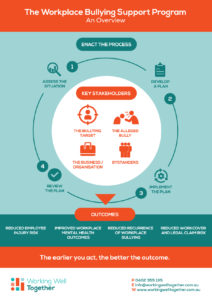Work Safe Australia’s recent report presents data that shows workplace mental health injury claims are increasing in relation to both lost time at work and cost. Money that could be used in achieving your business goals or keeping you clients or customers happy is instead being spent on managing claims and Workcover premiums.
If this trend is to stop, our companies need to explore new ways of addressing this issue. This includes the right support at the right time. This can be a key factor in mitigating, or at least early intervention, to mitigate the injury and the Workcover risk to your company.
When is the right time to engage workplace bullying support?
The earlier you act the better the outcome for you company and your employee. There are many indicators sounding the alarm to act. This includes:
- The most obvious when the bullying word comes up in conversation. An employee might say “I am being bullied” or “I am feeling bullied”.
- If they don’t use the word bullying, they might talk about having difficulties with another employee that have been on-going over a period of time. They might talk about not being able to talk to that employee (a fear driven response) or being excluded. They might overtly tell you they are afraid of that person.
- The employee may present as tearful or crying when they talk about a work situation with a colleague or colleagues. They might be showing signs of anxiety or distress. Looking down when they talk to you in an almost whispered voice.
- Their sick leave usage has increased in recent times.
- Or you as the employer can see there is a repeated pattern of behaviour one of your employees is subject to, which yuo think could be bullying.
These possible scenarios is where your warning bells should be triggering you into action. Signs like absenteeism, emotional distress, anxiety are indicators of injury. At this time, you need to actively focus on engaging and/or encouraging support.
Should you engage support before it is proven bullying?
You might want to wait until it’s proven bullying before implementing support, but the risk then becomes the longer the situation progresses without support, the more time there is for the employee’s health or injury to worsen. Appropriate support should involve an assessment at the time of referral for signs of injury and development of a support plan. This is directly targeted to address the injury risk and your business risk as well.
In my experience, some employees I support are being bullied. Others are not, but may bring other experiences from previous workplaces or home life. However, on most occasions something in the current workplace, be it person or work system, is triggering that employee to a response. This is sometime overt, sometimes not, but it is never so simple or clear cut.
Are you curious to learn how we can help you provide support to an employee during a workplace bullying support claim?
Contact us today for a confidential discussion on how we can help.
Learn more about our Workplace Bullying Support Program


